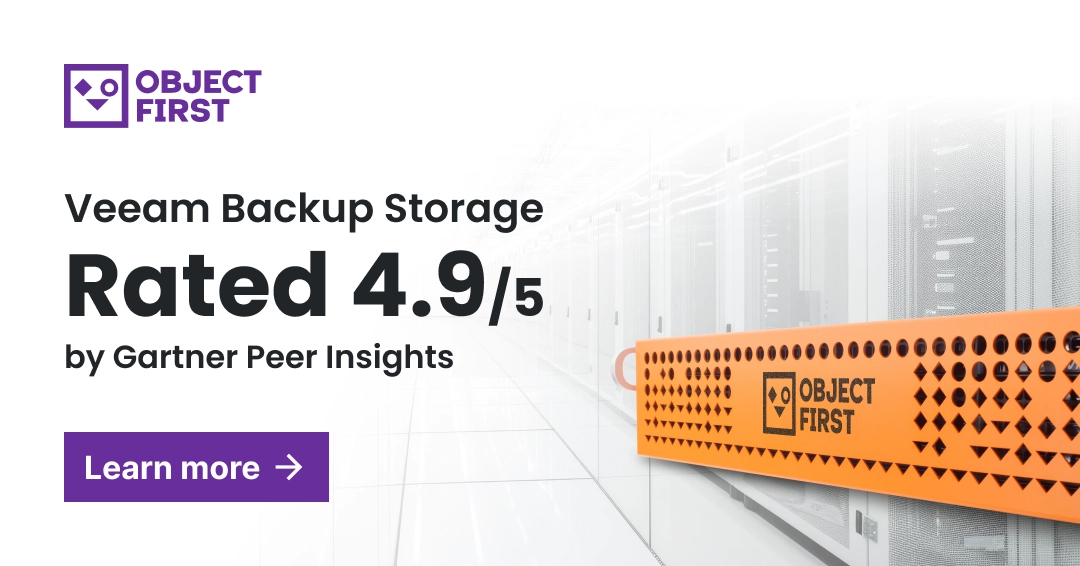Data Backup and Recovery: The Difference and Importance
Imagine a fortress of digital walls and encrypted gates standing guard over the most valuable treasure of the 21st century: data. With the U.S. Department of State projecting cybercrime's annual cost to exceed $23 trillion by 2027, defending this treasure becomes imperative for survival.
Dive into data backup and recovery, the vital defense mechanism ready to shield your digital environment from cyber threats and mitigate data loss impacts, ensuring your business's resilience and growth.
What Is Backup and Recovery?
Data backup and recovery is a comprehensive process that involves replicating data to a secure location to protect against potential loss or corruption and swiftly recovering it if needed.
This approach allows the data to be restored from the backup storage to its original place or an alternate site for continued operation. Ensuring the backup remains immutable or unchangeable post-creation is crucial for ransomware protection.
The process is underpinned by on-site and cloud-based solutions that facilitate automation and support for safeguarding organizational data, which are critical for operational integrity and regulatory compliance.
Why Are Data Backup and Recovery Important?
The National Cybersecurity Alliance indicates that 60% of small businesses close within six months after significant data loss, so the necessity for robust backup and recovery strategies becomes starkly evident.
Here's why these measures are indispensable:
- Guard Against Data Loss: Cyberattacks, system failures, or human error can devastate a company's operations and reputation. Backup and recovery are essential for safeguarding and restoring data when necessary.
- Enhance Customer Relations: Reliable customer data access improves service, boosts loyalty, and increases profitability while complying with data privacy regulations.
- Preserve Historical Data: Backups create operational archives vital for analysis, compliance, and strategic planning.
- Meet Regulatory Compliance: Backing up financial and critical business data ensures regulatory compliance and avoids legal issues.
- Ensure Operational Continuity: A robust backup and recovery plan helps organizations continue operations despite disasters, including cyber threats.
- Increase Employee Efficiency: A dependable data recovery system reduces the need to redo lost work, improves productivity, and allows focus on essential tasks.
The Difference Between Backup and Recovery
The difference between backup and recovery lies in their fundamental functions and importance within an organization's data management framework.
Backup serves as a preventive measure, focusing on securing and systematically archiving production data for safekeeping and potential future use.
Conversely, recovery is an emergency response action aimed at retrieving and reinstating this stored data to operational systems, which is crucial for minimizing downtime and ensuring uninterrupted business continuity.
Below is a detailed breakdown of the distinctions between data backup and recovery:
Key aspects | Backup | Recovery |
| Purpose of Action | The proactive step of copying and storing data to ensure it's available for future restoration needs and to defend against data loss. | The reactive process of reinstating data from backups into the production environment after a loss or corruption, aiming to minimize operational downtime. |
| Operational Focus | Emphasizes regular and secure data duplication, prioritizing preserving current data states for future access. | Concentrates on the rapid and efficient reinstatement of data, with a focus on resuming business operations as swiftly as possible. |
| Strategic Value | A critical component of an organization's data resilience framework, serving as a fail-safe against irreversible data loss. | Pivotal in business continuity strategies, ensuring businesses can quickly recover from data loss incidents and maintain operational integrity. |
| Scalability and Accessibility | Provides adaptable and expansive secure data storage solutions, facilitating ransomware backup protection across diverse locations and scales. | Underscores the importance of quick and straightforward data restoration, ensuring businesses can efficiently access and restore critical data when needed. |
Types of Data Backup
Grasping the subtleties of data backup methods is vital, especially considering that nearly 94% of companies experiencing severe data loss never recover.
That's why it's so important to have a solid plan for protecting your data, as each backup type offers unique advantages tailored to specific recovery scenarios.
Full Backup
- Overview: The most thorough, full backup duplicates all selected data. It's foundational for a solid data protection plan and ensures easy recovery. The trade-offs are the significant storage space and time required, which may only suit some organizations for regular execution.
- How It Works: It involves scheduling full backups daily with a 24-hour RTO. This exhaustive approach replicates every piece of data, demanding considerable storage and time but ensuring comprehensive coverage.
Differential Backup
- Overview: This backup type only stores changes made since the last full backup, balancing thoroughness and efficiency. It saves time and storage but complicates recovery by merging data from the original full and differential backups.
- How It Works: Schedule differential backups to record data changes after a full backup. This data backup strategy requires less storage and simplifies recovery despite its mild complexity.
Incremental Backup
- Overview: Incremental backups capture only changes since the last backup, significantly reducing storage and time requirements. This method is the most efficient, streamlining the backup process and minimizing storage use.
- How It Works: After a full backup, it captures file changes, such as additions, deletions, and modifications, creating a backup chain that requires a sequential restoration process but greatly reduces the storage footprint.
Mirror Backup
- Overview: Mirror backups replicate source data in real-time without alterations, offering an up-to-date recovery option that perfectly matches the original. They are ideal for scenarios needing immediate, unchanged data access.
- How It Works: Real-time replication ensures a live, exact copy of the source data, reflecting every change instantly. It provides a precise copy for quick recovery, bypassing the need for decompression or decryption.
Types of Data Recovery
Mastering various data recovery types becomes paramount as data creation and storage soar, while downtime costs an average of $88,000 per hour.
Below are key recovery methods tailored to meet specific requirements efficiently.
Granular Recovery
- Overview: This recovery type focuses on precisely restoring specific files, folders, or objects, allowing for quick access to essential data without restoring entire volumes.
- How It Works: Targets and retrieves individual data sets or objects from a larger data pool, enabling swift ransomware recovery of crucial information.
Instant Mass Restore
- Overview: It enables IT teams to rapidly restore hundreds of virtual machines (VMs) simultaneously, reducing downtime and resource consumption.
- How It Works: It utilizes advanced technology to instantly restore VMs to any previous state across multiple systems, streamlining the recovery process at scale.
Volume Recovery
- Overview: Designed for scenarios requiring the simultaneous recovery of an extensive number of VMs, such as all VMs within a specific application group, enhancing speed and efficiency.
- How It Works: Employs comprehensive recovery processes to restore large volumes of VMs in unison, ensuring a quick return to operational status.
Virtual Machine Disk (VMDK) Recovery
- Overview: Focuses on completely restoring all data and applications on a virtual machine disk, ensuring no component is left behind.
- How It Works: Reinstates the entire VM disk content, including data and applications, to its previous state, securing the integrity of virtual environments.
Bare Machine Recovery
- Overview: Involves restoring an entire system, operating system, software, apps, and data from scratch, ideal for disaster recovery situations.
- How It Works: Implements a complete system restoration process that redeploys the OS and all associated data and applications, effectively rebuilding the machine.
Instant Volume Mounts
- Overview: This allows teams to use a backup solution as a target to rapidly restore an entire volume to a Windows VM, saving significant time.
- How It Works: Directly mounts backup volumes to Windows VMs, enabling quick access to data and applications without full restoration processes.
Instant Restores of VMs
- Overview: This process facilitates the restoration of a large number of VMs to any specified recovery point, with backup copies ready for immediate use.
- How It Works: It quickly returns VMs to designated recovery points, ensuring they are immediately operational with fully hydrated backup copies.
Why Is It Necessary to Have a Backup and Recovery Plan?
A recovery plan outlines an organization's strategies and steps to recover lost data and resume operations post-disaster.
This blueprint encompasses technological solutions and human action plans, ensuring a swift and coordinated response to various incidents, from cyberattacks to natural disasters.
The Importance of a Backup and Recovery Plan
- Strategic Recovery Roadmap: Unlike ad-hoc backup measures, a planned approach outlines clear recovery paths post-disaster, delineating roles, actions, and priorities to minimize downtime and operational disruption.
- Protection Across All Fronts: The plan ensures data integrity in various scenarios, from daily operations to long-term archival. Whether moving data for day-to-day needs or safeguarding it against cyber threats, it offers a protective shield.
- Operational and Customer Service Continuity: By facilitating rapid data recovery, guaranteeing business operations and customer services remain uninterrupted, preserving customer satisfaction and loyalty even in the face of disruptions.
- Regulatory and Compliance Assurance: Tailored to meet the specific compliance needs of different industries, a well-crafted plan ensures that all data handling and storage practices comply with legal requirements, avoiding potential fines and legal entanglements.
- Business Resilience and Peace of Mind: A robust backup and recovery plan instills confidence among stakeholders and offers peace of mind that the business is well-equipped to handle and recover from unforeseen data loss incidents.
Enhancing Disaster Recovery Plan with RTO and RPO
Implementing a Recovery Time Objective (RTO) and Recovery Point Objective (RPO) within your disaster recovery plan will minimize the impact of disruptions.
- RTO measures the maximum time your organization can afford without access to its data and systems post-disaster. Setting an RTO ensures you have a target for restoring operations to avoid prolonged downtime, which is critical in today's fast-paced market.
- RPO defines the maximum age of files that must be recovered from backup storage for normal operations to resume without significant loss. It dictates your backup frequency, ensuring data is updated regularly and loss is minimized.
By adopting RTO and RPO metrics, you can prepare more effectively for disasters, ensuring that recovery processes are planned and practically aligned with business continuity goals.
Ootbi by Object First Approach to Backup and Recovery
Knowing that object storage is best for backup and recovery, Veeam founders established Object First and designed the ransomware-proof and immutable out-of-the-box Ootbi appliance.
Ootbi is built on the latest Zero Trust and data security principles and delivers S3 native immutable object storage designed and optimized for unbeatable Veeam backup and recovery performance.
Download a white paper and learn 3 reasons why Ootbi is the best storage for Veeam.
FAQ
What Types of Data Sources Typically Need to Be Recovered?
Virtually all data sources an organization safeguards might require recovery at some point. It spans VMs (across platforms like VMware, Microsoft, and Nutanix), physical servers (Windows, Linux), various databases (RDBMS, NoSQL, Hadoop, Mongo, Apache, etc.), files (NAS), containers (Kubernetes), applications (Microsoft Exchange, SAP HANA), SaaS applications (Microsoft 365, Salesforce), primary storage, and even mainframes.
What Is Disaster Recovery Backup?
Disaster recovery backup is a safeguard against catastrophic events that can disrupt operations and compromise data, whether through natural disasters or human-made issues like ransomware attacks. It involves setting aside comprehensive backups, possibly in the cloud, to ensure swift data availability and restoration to maintain business continuity.
What Is Data Backup and Recovery Software?
Data backup and recovery software automates the creation of secure copies of data and restoring them when needed. Veeam is a prominent example, offering robust solutions for various data types and environments. Object First's Ootbi provides a ransomware-proof and immutable storage solution, making it an ideal choice for enhancing Veeam's backup and recovery capabilities.
How Often Should Data Backups Occur?
The frequency of data backups should align with an organization's Recovery Point Objective (RPO), determined by how much data the business can afford to lose. For critical data, backups might be necessary multiple times a day, whereas less critical information may require less frequent backups.
Can Backup and Recovery Plans Prevent Ransomware Attacks?
While backup and recovery plans cannot prevent ransomware attacks, they are crucial in mitigating the impact. Organizations can restore their data without paying ransoms by maintaining up-to-date, immutable backups, effectively minimizing disruption and loss.
Why is Immutable Storage Important for Backup and Recovery?
Immutable storage is critical because it prevents data from being altered or deleted once written, offering a strong defense against ransomware and malicious tampering. Organizations with immutable storage, such as Ootbi, ensure that their backup data remains intact and recoverable, irrespective of external threats.


